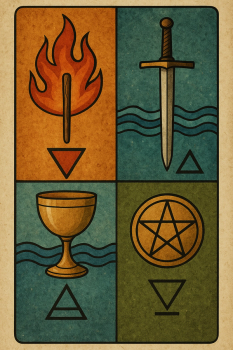
The Four Tarot Suits & The Elements: Decoding Their Deeper Mystical Links
The Occult Foundation: Why Elements Matter in Tarot
The elemental structure of the tarot is no mere artistic embellishment; it is an inheritance from Hermetic, Qabalistic, and alchemical systems that sought to encode the universe in four essential principles: Fire, Water, Air, and Earth. Each element represents both material and spiritual forces at play, and by aligning them with the four suits of the Minor Arcana, the tarot becomes a microcosm — a portable mandala of natural and metaphysical law.
This elemental alignment did not arise arbitrarily. In medieval and Renaissance occultism, the four elements were seen as building blocks of all creation, bridging the visible world and its invisible currents. Thus, the tarot suits do far more than merely decorate a deck — they reveal the very architecture of existence.
Wands & Fire: The Force of Will and Creation
The suit of Wands corresponds to Fire, embodying vitality, initiative, passion, and the driving spark behind all creation. Fire is expansive, dynamic, and consuming — it is both the forge of transformation and the blaze of ambition.
When Wands appear in a spread, they often point to areas where your will must be asserted, projects ignited, or desires acknowledged. At its highest octave, Fire represents the spiritual will (Thelema itself in many systems) — the capacity to enact one's True Will in the world.
For deeper context on how the suits relate to spiritual structure, see the foundational article: The Four Tarot Suits and the Elements: Decoding Their Deeper Mystical Links
Cups & Water: The Flow of Emotion and the Subconscious
The suit of Cups aligns with Water, the element of feeling, intuition, dreams, and relational bonds. Water symbolizes depth and receptivity, reflecting both the soul’s mysteries and the tender exchanges of love, compassion, and longing.
In the tarot, Cups frequently explore themes of emotional fulfillment, psychic impressions, or inner healing. Water also connects to the astral realm in esoteric systems, signifying the currents that shape imagination and subtle perception.
To compare emotional archetypes in practice, the Six of Cups offers a vivid example of Tiphareth expressed through Water.
Swords & Air: The Realm of Thought and Conflict
The suit of Swords is paired with Air, governing intellect, communication, analysis, and often, strife. Air cuts and clarifies; it is the element that distinguishes and defines. It fuels mental clarity but also rationalization and argument.
When Swords dominate a reading, they point to matters of decision, ethical dilemmas, or intellectual breakthroughs. In the Qabalistic framework, Air bridges the creative fire above with the manifest earth below — making it indispensable in translating inspiration into form.
The harsh culmination of Air can be seen clearly in the Ten of Swords, where Malkuth expresses the collapse of mental force.
Pentacles & Earth: Manifestation and Material Mastery
The suit of Pentacles (or Disks in the Thoth system) resonates with Earth, symbolizing the tangible, the body, the work of the hands, and the resources that sustain life. Earth is stability, patience, and the slow alchemy of growth.
In the tarot, Pentacles reveal how spiritual or emotional currents crystallize into physical reality. They deal with wealth, health, vocation, and the grounding structures that support higher pursuits.
A Subtle Interplay: Beyond Simple Correspondence
Serious students of the tarot and Qabalah recognize that these suits and their elemental attributions are more than static categories. They interpenetrate — Fire relies on Air to breathe, Water nourishes Earth, and so on. This interplay is mapped in systems like the Hermetic Tree of Life, explored in How the Qabalah Shapes Modern Tarot Meanings, where elemental forces cross and recombine on every path.
Aleister Crowley, in his Book of Thoth, emphasized this complexity by redefining the suits in his Thoth Tarot with deeper astrological and elemental dignities, underscoring that these are living symbols, not dead allegories.
For additional comparison between Qabalistic and Golden Dawn structures, see Thoth Tarot vs. Rider Waite.
Why This Matters in Practice
Understanding the elemental architecture grants far more than surface interpretations. It explains, for example, why:
- A Nine of Swords (Air) torments the mind
- A Nine of Cups (Water) nourishes the heart
This elemental lens refines how spreads are read, how cards interrelate, and how the deck becomes a symbolic echo of universal processes. For those working with ritual magic, astrology, or the Hermetic Qabalah, these connections open new avenues for integrated spiritual practice.
If you're learning tarot from the ground up, this understanding pairs well with Tarot 101: The Basics of Tarot Reading for a Modern Seeker.
In Closing
The tarot’s four suits and their elemental correspondences are far more than categories for fortune-telling; they are portals into the perennial philosophy underlying Western esotericism.
By meditating on the suits as expressions of Fire, Water, Air, and Earth, practitioners align themselves with forces shaping both cosmos and soul — turning each reading into a ritual act of harmonizing with the deeper currents of existence.
Related Articles
Your First Tarot Deck Must Be a Gift: Fact or Fiction?
Debunking the myth that your first tarot deck must be a gift—why it’s a superstition, what tarot experts say, and how intention and connection truly matter.
The Ultimate Guide to Daily Tarot Pulls
Discover how daily tarot pulls help you build intuition, gain self-awareness, and learn tarot card meanings. Step-by-step guide, journaling tips, and FAQs.
You Must Be Psychic to Read Tarot: Truth or Total Myth?
Think you must be psychic to read tarot? Total myth. Discover why tarot is really about intuition, self-reflection, and personal growth — and how anyone can learn.